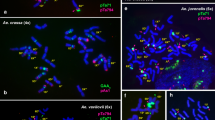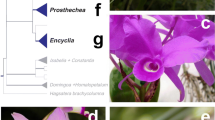Abstract.
Phylogenetic relationships of polyploid Aegilops species sharing the U-genome were investigated by analyzing heterochromatin banding patterns of their somatic metaphase chromosomes as revealed by C-banding and fluorescence in situ hybridization (FISH) with the heterochromatin-limited repetitive DNA probes pSc119, pAs1, as well as the distribution of NOR and 5S DNA loci revealed by pTa71 (18S-26S rDNA), and pTa794 (5S rDNA) probes. Seven tetraploid (Ae. triuncialis, Ae. peregrina, Ae. kotschyi, Ae. geniculata, Ae. biuncialis, Ae. columnaris, and 4x Ae. neglecta) and one hexaploid (6x Ae. neglecta) Aegilops species of the U-genome cluster were studied. The Ut and Ct chromosomes of 4x Ae. triuncialis (UtCt) were similar to the diploid donors Ae. umbellulata (U) and Ae. caudata (C). However, the size of the NOR locus on chromosome 5Ut was reduced. Karyotypic analyses confirmed that 4x Ae. peregrina (SpUp) was derived from a hybridization of the diploid species Ae. umbellulata with Ae. longissima, whereas Ae. umbellulata and Ae. sharonensis (or an immediate precursor) were the diploid progenitor species of Ae. kotschyi (SkUk). In both 4x species, the NORs on S-genome chromosomes were inactivated and were accompanied with a decrease or loss of rDNA sequences. Karyotypes of the tetraploid species, Ae. geniculata (UgMg) and Ae. biuncialis (UbMb) differed from each other and from the putative diploid progenitors Ae. umbellulata and Ae. comosa indicating that various types of chromosomal alterations occurred during speciation. Inactivation of major NORs on the M-genome chromosomes, redistribution of 5S rDNA sites, and loss of some minor 18S-26S rDNA loci were observed in Ae. geniculata and Ae. biuncialis. Significant differences in the total amount and distribution of heterochromatin, the number and location of 5S and 18S-26S rDNA loci observed between Ae. columnaris (UcXc)/4x Ae. neglecta (UnXn) and Ae. geniculata/Ae. biuncialis indicate that these species have different origins. Similarities in C-banding and FISH patterns of most Ae. columnaris and 4x Ae. neglecta chromosomes suggest that they were probably derived from a common ancestor, whereas distinct differences of three chromosome pairs may indicate that the divergence of these species was probably associated with chromosomal rearrangements and/or introgressive hybridization. Ae. umbellulata contributed the U genome, however, the source of their second genomes remains unknown. The formation of 6x Ae. neglecta (UnXnNn) was not associated with large modifications of the parental genomes.
Similar content being viewed by others
Author information
Authors and Affiliations
Corresponding author
Rights and permissions
About this article
Cite this article
Badaeva, E., Amosova, A., Samatadze, T. et al. Genome differentiation in Aegilops. 4. Evolution of the U-genome cluster. Plant Syst. Evol. 246, 45–76 (2004). https://doi.org/10.1007/s00606-003-0072-4
Received:
Published:
Issue Date:
DOI: https://doi.org/10.1007/s00606-003-0072-4




